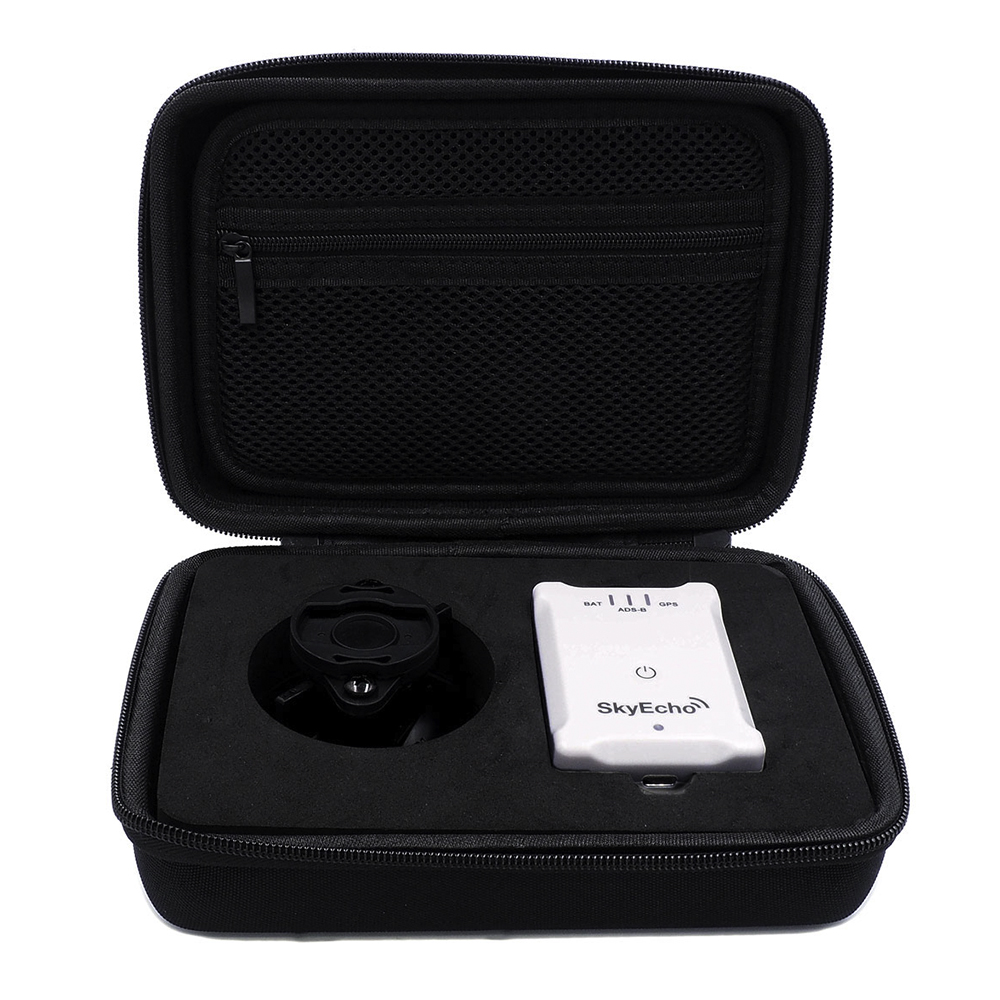Electronic Conspicuity vs. TABS

The Right of Way Discussion
Hey FAA, AOPA, NAAA, HAI, and Drone Industry at Large… We have to talk about this.
Last year when the BVLOS ARC came out with its recommendations, one of them created what I can only call a sh*t-storm of controversy. It all has to do with expanded use of ADS-B technology on crewed aircraft to assist UAS’ ability to Detect and Avoid (DAA) them. I’ll back up here in a moment and revisit that recommendation, but despite the hair-pulling and posturing against what some think of as an expansion of an ADS-B mandate – an underlying agreement between the sparing factions does exist, which in my words is this:
ADS-B OUT on Crewed Aircraft (CA) is a good thing that increases safety and makes DAA easier – AND – it’s expensive, so there should be a more efficient and lower cost alternative for aircraft that aren’t already under the existing mandate. Let’s break that down into its 2 parts:
Part 1: ADS-B OUT Increases Safety, or as we like to say “ADS-B is Drone Repellent”. Why? I feel like this is self-explanatory, but if you have ADS-B OUT on your crewed aircraft (CA) – you are literally shouting “HERE I COME! GET OUT OF MY WAY” from tens of miles away – if not more. From the drone operator’s perspective, ADS-B IN receivers on the drone itself are very easy to implement. uAvionix and several other companies manufacture add-on and OEM modules. Many drones come equipped with ADS-B IN as a standard safety capability, including several mass-produced models.
Part 1 isn’t controversial, it’s technical – and I won’t spend much more time on it.
Part 2: Why isn’t there something cheaper for the rest of us who don’t fly in airspace which mandates ADS-B? The ARC report latched onto something called TABS. I’ll dive into TABS in a bit, then go on to suggest that there is something even better, and cheaper than TABS.
Before that, it’s important to revisit the ARC recommendation to acknowledge the controversy. It recommended that in airspace below 500’ (very few of us should be here), that a crewed aircraft will only have Right of Way (RoW) over a UAS if it is making itself conspicuous with ADS-B OUT or TABS. I can understand the controversy there and I’m not weighing in on that topic for the rest of this article. What I want to address is the cheaper alternatives to installed ADS-B systems that meet the literal if not technical spirit of the recommendation. If we as an industry and a regulator can accept these alternatives, we take away the sting of the controversy by providing a cheap and safe alternative, right?
The Alternatives: TABS and Electronic Conspicuity (EC)
TABS
Traffic Awareness Beacon System (TABS) was conceived by the FAA and codified into TSO-C199 back in 2014. Here’s the intro from that TSO:
TABS devices are intended for voluntary equipage on aircraft exempted from carrying a transponder or [ADS-B] equipment, such as gliders, balloons and aircraft without electrical systems. TABS devices do not meet the transponder or ADS-B requirements […]. TABS equipment built to the minimum requirements of this TSO will enable an aircraft to be visible to other aircraft equipped with:
- Traffic Advisory System (TAS) as defined in TSO-C147()
- Traffic Alert and Collision Avoidance System I (TCAS I) as defined in TSO-C118()
- Traffic Alert and Collision Avoidance System II, (TCAS II), as defined in TSO-C119d
- ADS-B IN capability as defined in TSO-C154c, TSO-C166b, and TSO-C195b
Wow, that sounds – interoperable at least. It is a major acknowledgement that there are significant air-to-air benefits of ADS-B and transponders as opposed to surveillance by ATC only and maybe we should figure out a way to make those technologies available to aircraft that are challenged by installation limitations.
I must admit, when I first learned of TABS back in 2014, I thought it was a great idea. A (presumably) lower cost alternative to installed systems that increases safety for all. No electrical system means battery powered right? If you are like me, you just immediately made the jump to portable ADS-B transmitters, right? (We were both wrong, read on).
So obviously the market was flooded with TABS devices, and everybody adopted them, right? Oh wait…sorry – nobody ever built one, ever. Not even uAvionix with our reputation of lower-cost safety enhancing systems. Red flag? It should be. Here are the challenges:
- Battery Powered does not mean portable. From our experience and discussions within FAA – an “installation” would still be required. “Installation” in this case may be as simple as a fixed external antenna, but there is still a cost associated with installing an antenna on a certified airframe.
- Certification is still required. TSO-C199 exists, which means there is a cost to obtaining that certification. Sure, it’s a lighter cert effort than a full transponder, but it still costs, and that cost gets passed along to the customer.
- Big one – It cannot be used in an aircraft that already has a transponder. Most aircraft that have not equipped with ADS-B OUT still have a Mode A/C transponder. The two devices can’t be used simultaneously, so unless the FAA allows the fully certified Mode A/C transponder to be turned off in favor of a TABS device (they might?) – the addressable market may be quite small – how many aircraft can we actually address here?
- It operates on 1090MHz. Getting a bit technical here, but we have pretty congested spectrum on 1090MHz. TABS does allow for lower power transmission, which is good. Using 1090MHz also eliminates the possibility of anonymous mode that is allowable on 978MHz UAT. Not a deal-breaker, but it adds overall overhead to the system as each device still needs to obtain and be programmed with a unique ICAO 24-bit address.
- It’s not that much cheaper, not really. When it comes down to it, the technical differences between a full transponder and a TABS don’t really reduce the manufacturing cost very much. Then, add certification costs and installation costs, and we estimate that you still will be in the range of $1,000-$1,500. A full transponder costs $2000 from several manufacturers. So, if I have the luxury of owning an aircraft and pay the high costs to maintain it year after year – am I really going to choose something that limits my flight operational area for a measly $500 and probably reduces the resale value of my aircraft compared to an aircraft with a fully compliant system installed? It really just doesn’t make much sense to do so.
Well, crap – I just rained on your BVLOS parade. There is however a better option – all the cool countries are doing it, and so should we.
Electronic Conspicuity (EC) Devices
A couple of years after the TABS spec came out, the UK CAA had the same idea of lowering the cost barrier to equip with technology that would enable SEE and BE SEEN. Electronic Conspicuity was their terminology. But the Brits lowered the bar even further with EC. Instead of coming up with a spec that was still interoperable with every surveillance system under the sun, they looked ahead to what was coming, and placed their bets only on ADS-B. Oh, and they allowed it to be truly portable with no installation whatsoever. We make the most popular model called the SkyEcho.
An EC device differs from TABS in important ways that really does result in cost reduction. The spec is called CAP1391, and has since been adopted by Australia and New Zealand, and is being evaluated by a half-dozen other countries.

- Portable means portable – SkyEcho is fully enclosed, and battery powered. Using a RAM suction mount, it sticks on your window. If you are familiar with our Sentry product line for ForeFlight – same idea, it just happens to transmit as well as receive.
- Low Power ADS-B OUT – it transmits ADS-B positions but doesn’t bother with interrogation responses from ATC or TCAS. It isn’t for ground-based surveillance by ATC, it is for air-to-air situational awareness. We don’t need 150 miles of transmit range, we need 10-20 (at most).
- It integrates with your favorite Electronic Flight Bag (EFB) – just about every EFB in the world is compatible and some have built in configuration tools to control its operation through the user interface.
- No Certification required. The manufacturers must submit a “Declaration of Conformity,” attesting to the claim that the standards are met, but traditional certification processes are not required.

- You can use it alongside your existing transponder. Extensive testing has been done in the UK, Australia and New Zealand on this – it doesn’t break the ATC system or cause controller confusion. No updates to those systems were necessary. This is really important, whereas TABS had a limited addressable market, EC can work with any Mode A/C/S transponder. (Not one with ADS-B already though – but why would you?)
- In the U.S., we can do this on UAT/978MHz where there is way more spectrum available, and it allows the use of anonymous mode. This means we won’t be using up precious ICAO 24-bit addresses, and that a renter can take his portable with him to every rental aircraft without reprogramming.
- It costs way less – about 1/3 the cost of a full transponder and with no installation cost.
Circling Back
So, coming back to where we started – there is a truly portable option on the table that has much broader aircraft applicability than a TABS device at a significantly lower cost. If we could enable here in the U.S. what other countries have already done – we can fast-track this solution to address the really-low altitude risk that the BVLOS ARC was trying to address with its recommendations. And I think we can do it at a price point which doesn’t feel like more regulatory oppression.
This is a call to action. We are months away from a proposed Part 108 BVLOS rule. We at uAvionix want to make sure all options are on the table. Over the next few months, we’ll be working to communicate the pros and cons of both TABS and EC while educating the crewed aviation stakeholders. Hey, here at uAvionix we pride ourselves on being pilots ourselves, and taking reasonable, smart approaches to airspace integration. Let’s pull together the crewed and uncrewed communities and advocate for EC capabilities on crewed aircraft that don’t have to equip per the mandate and enforce ADS-B IN on BVLOS UAS as a required DAA safety layer.
– Christian Ramsey, Managing Director Uncrewed Aviation


